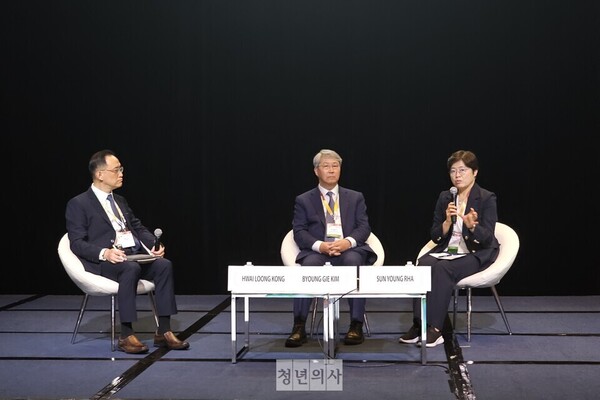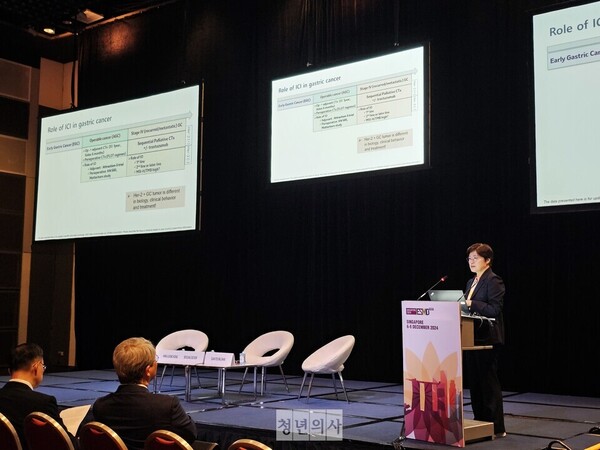SINGAPORE -- By Kim Chan-hyuk/Korea Biomedical Review correspondent -- “In treating gastric cancer, immuno-oncology agents go beyond prolonging survival to pave the way for precision medicine that considers patients’ individual tumor characteristics and immunity microenvironment. In the future, more biomarker studies and regionalized data will enable us to improve treatment outcomes continually.”

Professor Rha Sun-young of the Department of Medical Oncology at Yonsei Cancer Hospital said so during the MSD Satellite Symposium of the European Society for Medical Oncology Asia Annual Congress (ESMO Asia 2024) at the Suntec Convention & Exhibition Center in Singapore last Friday.
The symposium, held with the theme of “An Asian perspective: Evolving the standard of care through immuno-oncology,” shared the latest data on immuno-oncology, focusing on gastric and cervical cancers, which are highly prevalent in Asia, and discussed treatment strategies optimized for Asian patients.
Two Korean physicians—Professor Rha and Professor Kim Byoung-gie of the Department of Obstetrics and Gynecology at Samsung Medical Center—gave presentations focusing on the promise and challenges of immuno-oncology in the treatment of gastric and cervical cancer. They presented treatment approaches optimized for Asian patients.
“Gastric cancer is one of the most common cancers in Asia. While early diagnosis and multidisciplinary approaches improve outcomes, introducing precision medicine and immuno-oncology completely redefines treatment,” Professor Rha said, emphasizing the changes immuno-oncology has brought to clinical practice.
Notably, she highlighted results from the global phase 3 trial KEYNOTE-811, which showed that pembrolizumab (Keytruda) significantly improved overall survival (OS) in patients with PD-L1 expression (CPS ≥1), with complete remission (CR) observed in a subset of patients.
“The combination of pembrolizumab and chemotherapy does more than just prolong survival and may offer the possibility of a cure for some patients. This is a major turning point in the history of gastric cancer treatment,” Rha said.
“Immuno-oncology agents, including pembrolizumab, have been highly effective in combination with conventional chemotherapy. Moreover, their combination with ADCs can reduce toxicity and enhance targeted therapeutic effects. New drugs, including T-DXd (trastuzumab deruxtecan, such as Enhertu in trademark name), have shown positive results in the second or third-line treatment of gastric cancer. They are now being examined as first-line treatments.”
Dr. Rha also pointed to early data from the emerging Claudin 18.2 antibody therapy, zolbetuximab (Vyloy), saying, “Claudin 18.2 is showing promise in treating gastric cancer. Although the test is not yet standardized, it is expected to become a key pillar of gastric cancer treatment.”
In addition, Professor Rha noted the difference in response to treatment between Asian and Western patients.
“Asian patients often start treatment at a lower tumor burden due to higher rates of early diagnosis and a more multidisciplinary approach to treatment. Western patients, on the other hand, are often diagnosed after the onset of symptoms, resulting in different initial treatment conditions,” Rha explained.
Professor Kim focused on how immuno-oncology disrupts the stagnant paradigm of cervical cancer treatment.
“Cervical cancer has a particularly high incidence in Asia, but conventional treatments have not significantly improved survival over the past 25 years,” Dr. Kim said. “The combination of immuno-oncology and chemoradiotherapy has the potential to change that.”
In the KEYNOTE-A18 study, the immuno-oncology combination improved three-year overall survival (OS) by 82 percent in patients with locally advanced cervical cancer, especially in high-risk patients, he noted.
“In high-risk patients, these results are an important step toward setting a new standard of care for cervical cancer,” Kim said. “We can now look forward to even better outcomes.”
Professor Kim also emphasized the importance of data from Asian patients, noting that the KEYNOTE-A18 study included about 20 percent of Asian patients.
“Asian patients are more likely to experience higher toxicity from chemoradiotherapy than Western patients,” Kim said. “Therefore, close toxicity management and individualized treatment approaches are needed.”

The question-and-answer session that followed the presentation focused on optimizing immuno-oncology drugs for Asian patients, the role of new biomarkers, and refining treatment strategies.
Regarding treatment strategies based on PD-L1 expression, Dr. Rha said, “In patients with PD-L1 expression of CPS ≥10, the combination of immuno-oncology and chemotherapy is most effective. However, in patients with CPS 1-9, the effectiveness may be limited and should be discussed with the patient to determine the direction of treatment.”
“PD-L1 expression is an important biomarker, but it does not fully describe the immunologic milieu of the tumor,” Professor Rha said. “Expression levels are not continuous and are interpreted according to specific criteria, which makes it difficult to establish accurate cutoff values.”
“In global studies, such as KEYNOTE-811, the proportion of Asian patients is about 30 percent, which is critical for obtaining data tailored to Asian patients,” Rha noted the importance of Asian patient representation in large studies. “In certain biomarker studies, such as Claudin 18.2, the proportion of Asian patients is very high with 75-100 percent, which helps us understand regional characteristics.”
Regarding patient selection for immuno-oncology in cervical cancer, Professor Kim said, “The results of the KEYNOTE-A18 study showed that the effect of immuno-oncology was more pronounced in patients with CPS ≥1. However, certain patients may benefit even in patients with low CPS expression, so the treatment strategy should be carefully defined, especially in high-risk patients with lymph node metastases.”
When asked about the role of minimal residual disease (MRD) testing and PD-L1 expression in cervical cancer, Dr. Kim said, “Currently, there are limited data on whether treatment can be terminated early based on the presence of MRD, but the combination of PD-L1 expression and MRD data is likely to play an important role in future treatment strategies.”
Related articles
- AI predicts atrial fibrillation risk through ECG aging analysis: study
- Padcev combo therapy shows excellent effect on Asian patients with urothelial carcinoma. What's next?
- Will revised gastric cancer clinical guidelines address Vyloy’s diagnostic gap?
- Patient group urges faster access to Vyloy by reforming diagnostic rules
- A cervical cancer sample can diagnose cancer and analyze the microbiome simultaneously
- Experimental cancer drug targets immune cells to shrink hard-to-treat tumors in mice: study

